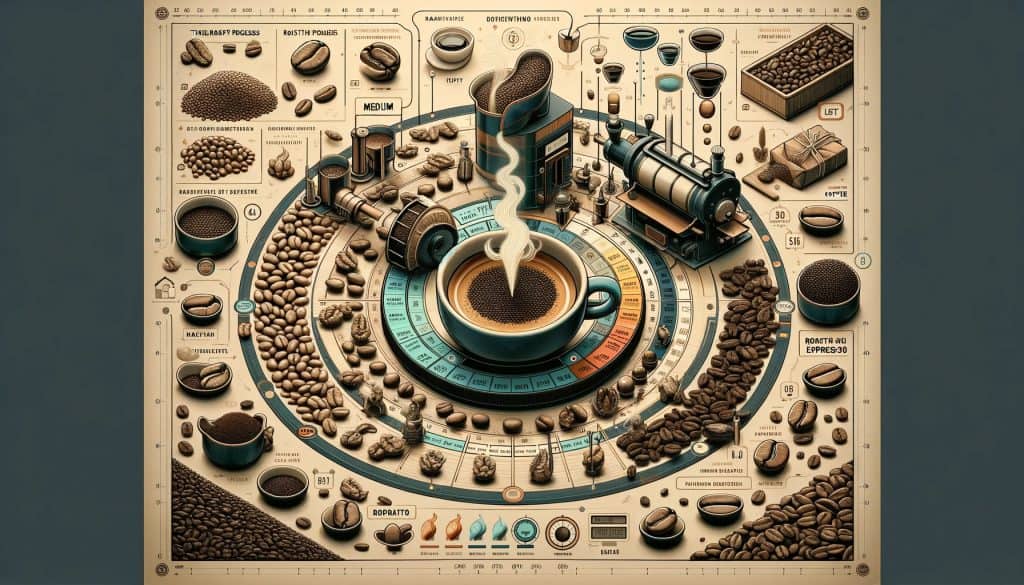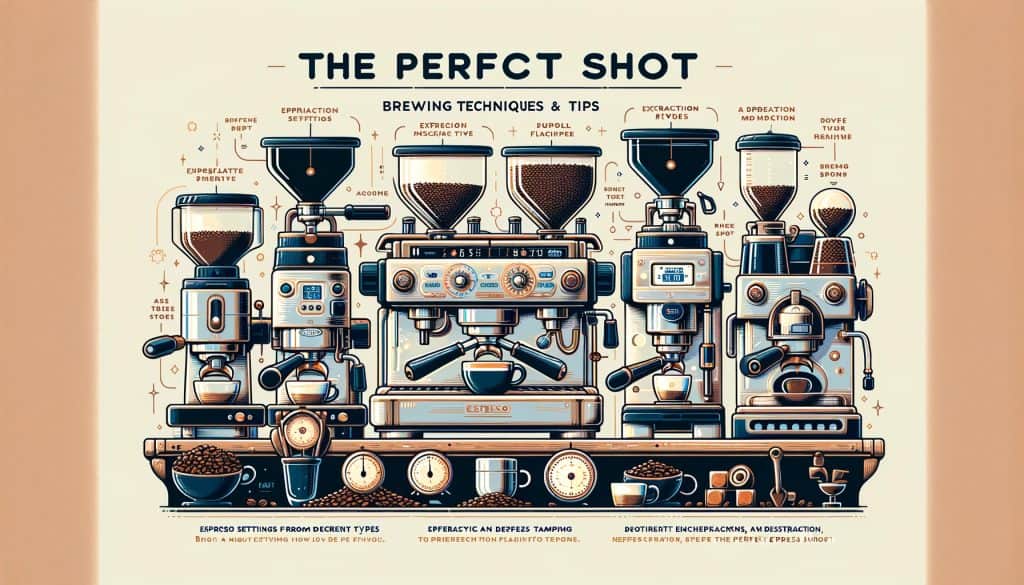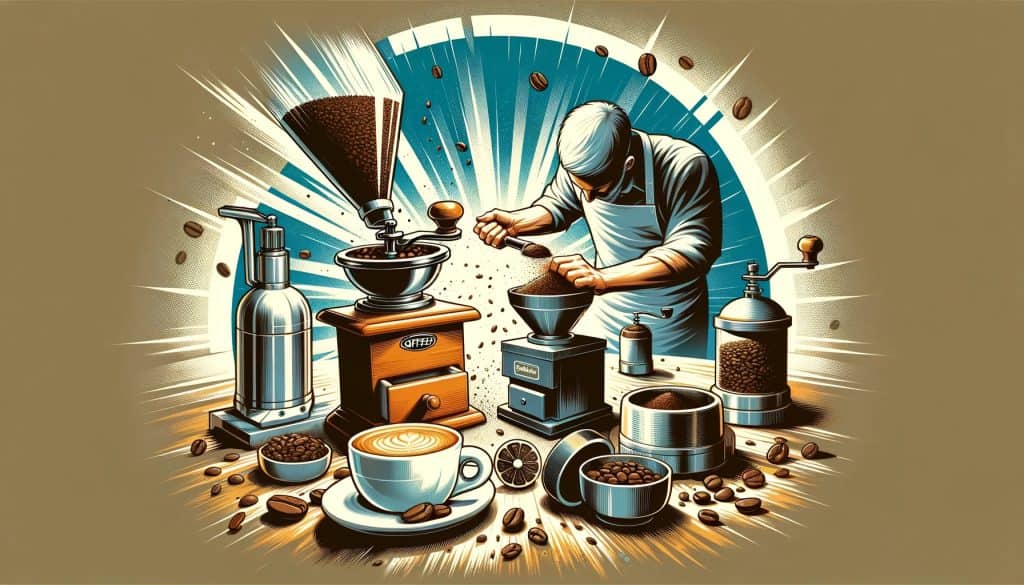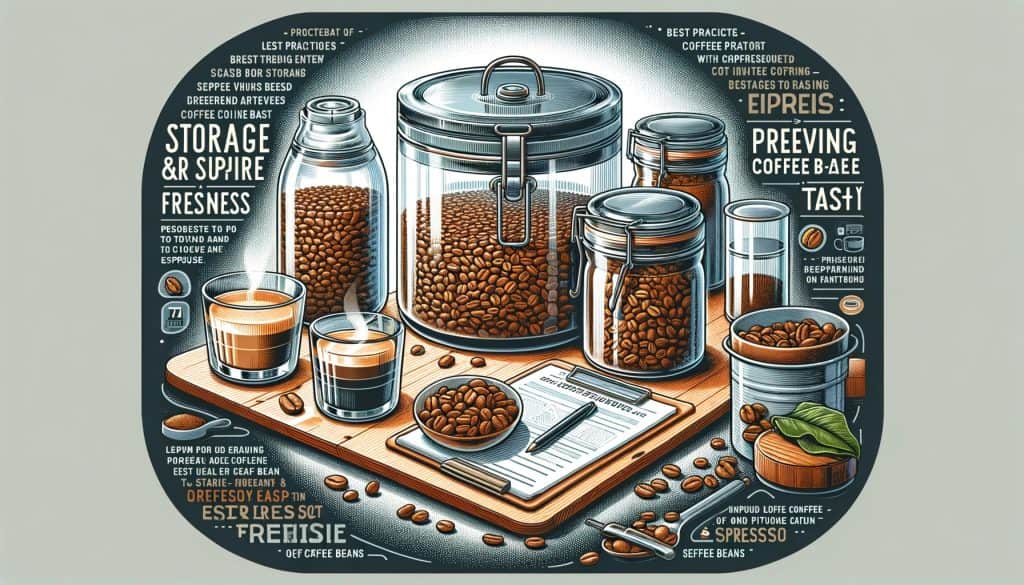Ever wondered why your espresso at home doesn’t quite hit the mark like the one at your favorite café? The secret might just lie in the beans you’re using.
As a coffee enthusiast, I’ve come to realize that the choice of coffee beans is not just a matter of taste – it’s an art form. The beans are the soul of your espresso, determining everything from its boldness and body to the subtleties of its flavor and aroma.
The Impact of Bean Variety
Let me tell you, not all beans are created equal when it comes to brewing that perfect cup of espresso at home. Each type of coffee bean, predominantly Arabica and Robusta, brings a unique character to the table.
Arabica beans, known for their sweet, soft taste and higher acidity, can add a range of flavors from fruity to floral, making your espresso a complex and aromatic experience. On the other hand, Robusta beans, with their stronger, harsher taste and higher caffeine content, give your espresso that extra kick and better crema, essential for espresso aficionados.
Coffee Bean Characteristics
| Bean Type | Flavor Profile | Acidity | Caffeine Content |
|---|---|---|---|
| Arabica | Fruity, Floral | Higher | Lower |
| Robusta | Strong, Harsh | Lower | Higher |
A Symphony of Flavors
When you pick a bag of coffee beans, you’re not just choosing a brand; you’re setting the stage for the flavor symphony in your cup. The origin of the beans, their roast, and even the way they’re ground and brewed play pivotal roles in shaping the final taste of your espresso.
For instance, beans from Latin America often have a nutty, chocolatey flavor, perfect for a smooth, comforting espresso. In contrast, African beans, like Ethiopian, can surprise you with floral and fruity notes, offering a more adventurous espresso experience.
Popular Coffee Bean Origins
- Latin America: Nutty, Chocolatey
- Africa: Floral, Fruity
- Asia: Earthy, Spicy
As we dive deeper into the world of coffee beans and home-brewed espresso in the sections to follow, remember this: choosing your coffee beans is not just a mundane step in the process. It’s the foundation of your espresso’s character.
Different coffee bean types have a significant impact on the flavor, aroma, and overall quality of your home-brewed espresso. So next time, before you brew, think about the journey you want your taste buds to take. After all, every cup of espresso is a story, and the beans are its narrator.
< class="wp-block-separator has-alpha-channel-opacity"/>Storage and Freshness: Preserving Coffee Bean Quality
When it comes to home-brewed espresso, the freshness of coffee beans is crucial. Their storage significantly affects the taste of your espresso. Here’s how you can ensure your beans stay fresh and your espresso remains delicious.

Good Practices for Storing Beans:
- Airtight Containers: Use containers that seal out air completely. Oxygen is a major culprit in making beans stale.
- Cool and Dark Places: Store your beans in a cool, dark place. Sunlight and heat can degrade the quality of your beans.
- Avoid Refrigeration: Contrary to popular belief, refrigerating your beans can introduce moisture, which is harmful.
- Quantity: Only buy as much as you can use in a few weeks. Freshness declines over time, even with the best storage.
Impact of Bean Freshness on Espresso Taste:
- Aroma: Fresh beans mean a more vibrant and inviting aroma.
- Flavor: The oils in fresh beans are responsible for the rich, full flavor of espresso.
- Acidity and Bitterness: Older beans can result in a more bitter, less pleasant brew.
Taking care of your coffee beans is taking care of your espresso experience. Proper storage not only extends the life of your beans but also ensures every cup of espresso is as perfect as it can be.
< class="wp-block-separator has-alpha-channel-opacity"/>Understanding Coffee Beans: An Overview
Coffee beans, the seeds of the coffee plant’s fruit, commonly referred to as coffee cherries, are the heart and soul of your daily brew. These beans, which are actually seeds, come in different varieties, each with unique characteristics and flavor profiles.
In this piece, I’ll dive into the fascinating world of coffee beans, exploring their types and what makes them so special in the coffee universe.

The Core Types of Coffee Beans
There are two main types of coffee beans that dominate the market: Arabica and Robusta. Let’s break them down:
- Arabica Beans:
- Flavor Profile: Generally smoother and sweeter with hints of sugar, fruits, and berries.
- Acidity: Higher in acidity, which lends a winey taste to the coffee.
- Where They Grow: Predominantly in Latin America, Eastern Africa, Asia, and Arabia.
- Robusta Beans:
- Flavor Profile: Stronger, harsher, and more bitter, often with a nutty or chocolaty note.
- Caffeine Content: Higher than Arabica, making it a punchier choice.
- Where They Grow: Commonly found in Africa, Indonesia, and Vietnam.
From Cherry to Cup: The Life of a Coffee Bean
Understanding the journey of a coffee bean helps in appreciating the complexity of your espresso. Here’s a simplified look:
- The Cherry:
- The coffee bean starts its life as a part of a cherry.
- The cherries are picked when they are brightly colored and ripe.
- The Bean:
- Inside each cherry are typically two beans, nestled face to face.
- These beans are removed from the cherry and dried.
- The Grounds:
- The dried beans are roasted, ground, and finally brewed into the coffee we drink.
- The grind size and method significantly affect the flavor profile.
Why This Matters
Understanding the types of beans and their journey from cherry to grounds can elevate your coffee experience. It’s not just about brewing; it’s about appreciating the art and science behind each cup. Whether you’re an Arabica aficionado or a Robusta rookie, the world of coffee beans is rich and ripe for exploration.
As we’ve seen, coffee beans are more than just ingredients; they’re the product of a complex and fascinating process, with a variety of types and characteristics. Next time you sip your espresso, think of the journey these beans have been on – it might just make your coffee taste even better.
< class="wp-block-separator has-alpha-channel-opacity"/>The Two Main Types of Coffee Beans: A Closer Look
Coffee enthusiasts know that the bean type is key to a perfect cup of espresso. Arabica and Robusta beans, the two primary warriors in the coffee world, each bring something unique to the table. Here, we delve into their distinct characteristics and how to best use them in your espresso machine.

Arabica Beans: The Refined Choice
Arabica beans are known for their smooth and complex flavor profile. Let’s break down what makes them special:
- Flavor Profile: They often have a sweeter, softer taste, with tones of sugar, fruit, and berries.
- Aroma: The aroma is rich and varied, ranging from floral to fruity.
- Acidity: Higher acidity gives Arabica its winey and fruity quality.
Good Practices for Brewing Arabica Beans in Espresso Machines
- Grind Size: A fine grind works best for espresso machines to fully extract the flavor.
- Water Temperature: Aim for about 200°F to avoid over-extracting.
- Tamping Pressure: Gentle but firm tamping ensures even water distribution.
Robusta Beans: The Bold Alternative
Robusta beans pack a punch with higher caffeine and a robust profile. Here’s what sets Robusta apart:
- Caffeine Content: They contain almost double the caffeine content of Arabica.
- Bitterness: A stronger, more bitter flavor, often with a nutty or chocolaty note.
- Crema Quality: Robusta beans are excellent for producing a rich, thick crema.
Ideal Roasting Levels for Robusta Beans in Espresso
- Medium Roast: Balances the inherent bitterness while enhancing the chocolatey notes.
- Dark Roast: Intensifies the bold flavor, ideal for a strong espresso shot.
Understanding these two types of beans is crucial for any home barista. Arabica beans are perfect for those who enjoy a more aromatic, nuanced cup, while Robusta beans are ideal for espresso lovers who crave intensity and richness. The right choice depends on your personal taste preferences and how you like your espresso. Happy brewing!
< class="wp-block-separator has-alpha-channel-opacity"/>Regional Variations in Coffee Beans: A World of Flavor
The world of coffee is as diverse as the regions that produce it. The flavor, aroma, and body of coffee beans vary significantly based on their geographic origin. In this exploration of coffee beans from Latin America, Africa, and Asia, we’ll see how terroir – the environment in which the beans are grown – plays a crucial role in shaping their unique characteristics.

Latin America: The Balanced Brew
Latin American coffee, especially Colombian beans, is renowned for its balance and mild flavor. Here’s what sets it apart:
- Colombian Coffee: Known for its balanced flavor, medium acidity, and a hint of nuttiness. It’s the archetype of a classic coffee.
- Characteristic Flavors: Expect notes of chocolate, nuts, and sometimes subtle hints of fruit.
| Country | Flavor Notes | Acidity Level |
|---|---|---|
| Colombia | Nutty, Chocolate | Medium |
| Brazil | Chocolate, Spiced | Low |
| Costa Rica | Fruity, Bright | High |
Africa: The Exotic and Complex
African coffees, like Ethiopian and Kenyan varieties, are famous for their exotic and complex profiles.
- Ethiopian Coffee: Known for its wine-like and fruity characteristics. It can range from floral and tea-like to full-bodied and chocolaty.
- Characteristic Flavors: Berry, wine, floral notes are common.
| Country | Flavor Notes | Body |
|---|---|---|
| Ethiopia | Fruity, Floral | Light-Medium |
| Kenya | Berry, Citrus | Full |
Asia: The Earthy and Bold
Asian coffees, particularly from Sumatra, are appreciated for their full body and earthy, bold flavors.
- Sumatran Coffee: Notable for its full body and low acidity. It often has a rich, earthy flavor with hints of herbs and spice.
- Characteristic Flavors: Earthy, spicy, and herbal notes.
| Country | Flavor Notes | Body |
|---|---|---|
| Sumatra | Earthy, Herbal | Full |
| Vietnam | Bold, Spicy | Medium-Full |
The diversity in coffee bean flavors from region to region is a testament to the rich tapestry of coffee culture worldwide. Whether you prefer the balanced notes of Latin America, the exotic profiles of Africa, or the boldness of Asia, there’s a world of flavors waiting to be explored in each cup.
So next time you sip on your espresso, remember the journey those beans have taken from a distant farm to your cup – it’s a global story in every sip!
< class="wp-block-separator has-alpha-channel-opacity"/>The Art of Roasting: Crafting Espresso’s Soul
Roasting coffee beans is an art form, a crucial step in shaping the final cup’s flavor and aroma. For espresso lovers, understanding how different roasting levels – light, medium, and dark – influence the quality of their beloved brew can elevate their appreciation and enjoyment. Let’s dive into the world of roasting and discover how it impacts espresso quality.

Roasting Levels: From Light to Dark
Each roasting level brings out unique characteristics in coffee beans:
Light Roast
- Characteristics: High acidity, pronounced origin flavors.
- Espresso Impact: Light roasts retain the bean’s original flavors, often resulting in a complex and brighter espresso with more pronounced acidity.
Medium Roast
- Characteristics: Balanced acidity, fuller body, enhanced flavor.
- Espresso Impact: This roast level brings a balance between acidity and body, making it a versatile choice for espresso. Expect a richer flavor than light roasts.
Dark Roast
- Characteristics: Low acidity, bold body, dominant roasting flavors.
- Espresso Impact: Dark roasts are all about boldness and body. The roasting flavors come to the forefront, often with a bittersweet aftertaste, perfect for those who enjoy a strong, heavy espresso.
Roasting Time and Temperature
The roasting process involves two key elements: time and temperature. Here’s how they play a role:
- Roasting Time: Longer roasting times lead to darker roasts. It’s a delicate balance; too long and the beans can become bitter.
- Temperature: Higher temperatures bring out more oils in the beans, contributing to a fuller-bodied, more intense flavor in espresso.
| Roast Level | Roasting Time | Temperature Range |
|---|---|---|
| Light | Short | Low-Medium |
| Medium | Medium | Medium-High |
| Dark | Long | High |
The roasting process is central to defining an espresso’s character. From light to dark, each roast level offers a different experience, catering to varied palates.
Whether you prefer the subtle, intricate flavors of a light roast or the bold, rich notes of a dark roast, the key lies in the balance of roasting time and temperature. As a coffee enthusiast, exploring these different roasts can be an exciting journey, leading to a more profound appreciation of your daily espresso.
< class="wp-block-separator has-alpha-channel-opacity"/>Crafting Harmony in a Cup: The Art of Coffee Blending
Blending coffee beans is much like orchestrating a symphony. Each bean, with its unique flavor profile, plays a crucial role in creating a harmonious blend. In the world of espresso, the blend of Arabica and Robusta beans is a popular choice, offering a balance of flavor, aroma, and body.
Let’s explore the intricacies of this blending art and some popular examples that coffee aficionados swear by.

Arabica and Robusta: A Perfect Pairing
Arabica Beans
- Characteristics: Noted for their sweet, soft taste and higher acidity.
- Role in Blends: Arabica beans are often used to add complexity and a smooth, rich flavor to the blend.
Robusta Beans
- Characteristics: Strong, full-bodied with a robust flavor and higher caffeine content.
- Role in Blends: Robusta beans add strength, crema, and a punchy edge, complementing the Arabica’s subtlety.
Popular Blends and Their Flavor Profiles
- Classic Italian Espresso Blend
- Composition: 70% Arabica, 30% Robusta.
- Flavor Profile: A well-balanced cup with rich crema, offering a smooth, slightly sweet flavor with a hint of robust strength.
- French Roast Blend
- Composition: 60% Arabica, 40% Robusta.
- Flavor Profile: A darker roast leading to a bold, intense flavor, with a touch of Arabica’s sweetness balancing the robustness.
- Breakfast Blend
- Composition: 80% Arabica, 20% Robusta.
- Flavor Profile: A lighter, more acidic brew, ideal for the morning rush, with just enough Robusta to add a kick.
- Barista’s Choice
- Composition: 50% Arabica, 50% Robusta.
- Flavor Profile: A bold, balanced, and full-flavored espresso, perfect for those who enjoy both worlds.
| Blend | Arabica | Robusta | Flavor Notes |
|---|---|---|---|
| Classic Italian | 70% | 30% | Smooth, Sweet, Slightly Strong |
| French Roast | 60% | 40% | Bold, Intense, Touch of Sweet |
| Breakfast | 80% | 20% | Light, Acidic, Morning Kick |
| Barista’s Choice | 50% | 50% | Bold, Balanced, Full-Flavored |
Blending coffee beans is a nuanced art, essential for crafting the perfect espresso. By combining Arabica and Robusta beans in varying proportions, baristas can create a wide range of flavor profiles, each with its unique appeal.
Whether you prefer a strong, bold espresso or a smooth, subtle one, there’s a blend out there for every palate. The joy of discovering your perfect blend is part of the great adventure that is coffee tasting.
< class="wp-block-separator has-alpha-channel-opacity"/>The Crucial Role of Grinding in Espresso Perfection
Creating the perfect espresso starts long before the coffee reaches the machine. It begins with the right grind. The size and consistency of your coffee grind are pivotal in determining the quality of the espresso shot. Let’s dive into why grind size matters and explore some of the best grinders you can use at home.

Why Grind Size and Consistency Matter
Grind Size
- Fine Grind: Essential for espresso, a fine grind allows for proper extraction, creating a rich and flavorful shot.
- Consistency: Uneven grinds lead to uneven extraction, resulting in a shot that can be both over and under-extracted.
The Role of the Grinder
- Burr Grinder: Provides uniform size, essential for a balanced espresso.
- Blade Grinder: Less consistent, can result in uneven extraction.
Recommended Grinders for Home Use
- Conical Burr Grinder
- Good For: Precision grinding, ideal for espresso.
- Pros: Consistent grind size, adjustable settings.
- Cons: Higher cost, more maintenance.
- Flat Burr Grinder
- Good For: Achieving a uniform grind.
- Pros: Excellent consistency, durable.
- Cons: Can be noisy, slightly expensive.
- Manual Burr Grinder
- Good For: Those who enjoy the process.
- Pros: Cost-effective, portable.
- Cons: Requires effort, less consistent than electric burrs.
- Blade Grinder
- Good For: Budget option, versatile.
- Pros: Affordable, easy to use.
- Cons: Inconsistent grind, not ideal for espresso.
| Grinder Type | Good For | Pros | Cons |
|---|---|---|---|
| Conical Burr | Precision Grinding | Consistent, Adjustable | Higher Cost, More Maintenance |
| Flat Burr | Uniform Grind | Consistency, Durability | Noisy, Slightly Expensive |
| Manual Burr | Manual Process | Cost-Effective, Portable | More Effort, Less Consistent |
| Blade | Budget Option | Affordable, Easy to Use | Inconsistent, Not Ideal for Espresso |
The right grinder is a crucial investment for any espresso enthusiast. While a burr grinder (be it conical or flat) is the ideal choice for achieving the perfect grind size and consistency, there are options for every preference and budget.
Remember, a great espresso shot is a harmony of many elements, and grinding is the first note of that symphony. Choose wisely and elevate your home espresso game to the next level.
< class="wp-block-separator has-alpha-channel-opacity"/>Mastering the Art of Espresso: A Conclusive Insight
Espresso is more than just a beverage; it’s a symphony of flavors and aromas, each note influenced by various factors from bean to cup.
In this journey t ough the world of espresso, we’ve explored how coffee bean type, origin, roasting, and preparation methods contribute to the final cup’s quality. Let’s recap and encourage you to embark on your own espresso experiments.

Key Elements Influencing Espresso Quality
- Coffee Bean Type: Arabica and Robusta beans each bring unique characteristics to your espresso. Arabica offers a smoother, more aromatic experience, while Robusta adds a punchy caffeine kick and a robust crema.
- Bean Origin: Beans from different regions – Latin America, Africa, Asia – each have distinct flavors. Ethiopian beans might bring floral notes, while Sumatran beans could add an earthy depth.
- Roasting Process: Light, medium, and dark roasts dramatically alter the beans’ flavor and aroma profiles. A light roast can highlight the bean’s inherent qualities, while a dark roast brings out bolder, more caramelized flavors.
- Preparation Methods: From grinding to brewing, each step plays a pivotal role. The grind size, water temperature, and pressure can all affect the extraction and ultimately the taste of your espresso.
Experiment and Explore
| Element | Exploration Ideas |
|---|---|
| Bean Type | Mix Arabica and Robusta to find your blend. |
| Origin | Try single-origin and blended espressos. |
| Roast Level | Experiment with different roast profiles. |
| Brewing Method | Play with grind sizes and brewing pressures. |
The world of espresso is vast and varied. I encourage you to experiment. Blend different types of beans. Try espressos from various regions. Adjust your roasting levels and tweak your brewing techniques. Each adjustment opens up a new spectrum of flavors and experiences.
Understanding the nuances of espresso is a journey, not a destination. It’s about experimenting, learning, and most importantly, enjoying the process. As you explore, you’ll develop a deeper appreciation for the art and science behind every cup.
So go ahead, experiment with different beans, origins, roasts, and brewing methods to find your perfect espresso. The possibilities are endless, and the rewards are immensely satisfying.
< class="wp-block-separator has-alpha-channel-opacity"/>

